► CAR’s editor reviews 2017 Tokyo show
► ‘Beyond the motor’ mantra
► Trends, themes and what stole attention
To reach Big Sight, Tokyo’s dockside exhibition centre, you ride a monorail that’d sit quite happily in Blade Runner 2049. On towering infrastructure, you’re borne across the city hundreds of feet above street level. (Or rather street levels – in Tokyo you’re never quite sure when you’re on terra firma, so often does another carriageway materialise above or below you, or both).
Along these streets teems a never-ending stream of traffic as varied as it eclectic, much of it proudly 20th century, some of it conspicuously progressive. Almost like the car’s undergoing a period of seismic change…
At its core, Tokyo 2017 was a collective groping around for answers, even if its stars were more generous with striking design than they were with actual solutions.
Our guide to the latest Tokyo motor show
Mazda leads the way with a duo of stunners
Top of the design tree was Mazda, the tiny Japanese brand with the aesthetic genius to go toe-to-toe with Europe’s best. The Vision Coupe is beautiful, pure and simple: a virtuoso exercise in three-dimensional automotive poetry and proof that designer Ikuo Maeda is both among the game’s very best and a bigger Mazda asset than even very clever combustion engines.
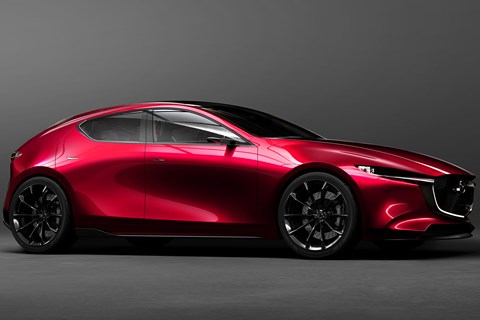
Incredibly his Kai concept, which previews the next Mazda 3, was just as striking, despite being more tightly bound by the restraints of reality.
The future might be turbulently unpredictable but one thing’s for sure: if it wears a Mazda badge, the future will at least be easy on the eye.
A century of greatness
Nothing reflected the show’s central tenet of ‘Beyond the motor’ better than Toyota’s stand. In one corner, the third-generation Century, unveiled at the show. The first two generations saw Japan’s most discerning passengers – business moguls and monarchs mostly – through from 1967 until now, so a new Century is big news, in Japan at least.
Gone is the second generation’s V12 engine (the Century remains the only Toyota to feature a V12), replaced by a hybrid V8 in a reluctant nod to modernity. That’s it, though: the third Century gives no ground on the timelessness of either its design or its luxury-with-eccentricity remit.
The electronics and NVH engineering may be from the drawer marked Lexus but they’re wrapped in a yesteryear cocoon that’s as thin on options (leather or cooler woollen upholstery; that’s it) as it is heavy on idiosyncratically
Japanese luxury, notably net curtains – a more dignified alternative to darkened privacy glass. Production of the third Century has already begun, and the car will be built at the dizzying rate of just three per day.
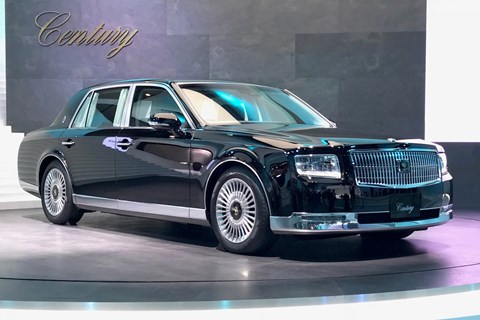
Toyota TJ: Cruising in style
In stark contrast stood Toyota’s TJ Cruiser, a ruggedly handsome lifestyle SUV that draws on Toyota’s rich design lineage in all things all-wheel drive and utilitarian cool. Powered by a hybrid drivetrain and endlessly reconfigurable to better carry friends or surfboards as you wish, the TJ Cruiser concept is unlikely to remain a concept for long given production of the successful (in the US) FJ Cruiser has ended.
Concept-i – a mind-shift
Toyota also showed a series of more free-thinking concepts, the most striking of which was the Concept-i. Chock full of well-worn concept car styling must-haves, the clever bit was the artificial intelligence and mood-recognition systems. By analysing the driver’s facial expressions and movements, Concept-i works to extrapolate your state of mind and act accordingly.
If you’re looking ill-tempered the car will try to cheer you up with a favourite track or dinner destination, just as it will ramp up its autonomous driving assists if it decides you’ve had a long day. Intriguing stuff, and similar thinking was evident in several other Tokyo 2017 concepts, not least Honda’s Sports EV Concept, successor to Frankfurt’s wildly successful Urban EV Concept.
And last but not least from Toyota, the intriguing Fine-Comfort Ride, a proposal for a luxury hydrogen fuel cell alternative to an S-Class. Its killer USP? The ability, via odour dispensers and screens on the cars inner surfaces, to take you anywhere, regardless of the environment the car’s actually travelling through.
So, you could be enjoying the tranquillity of the Alps as your silent, zero-emission Fine-Comfort Ride negotiates the inhospitable M25. Yes please.
Honda’s EV design revolution
As VW has with its ID Buzz, Honda’s looked to the past to gloss its next-generation EVs with nostalgia-spiked desire. In truth, it feels like the Japanese giant is still reeling from the global outpouring of love prompted by its ultra-cute, original Civic-inspired Urban EV Concept. To follow it the gorgeous, low-slung Sports EV Concept was rushed from sketch to finished show car in a matter of months.
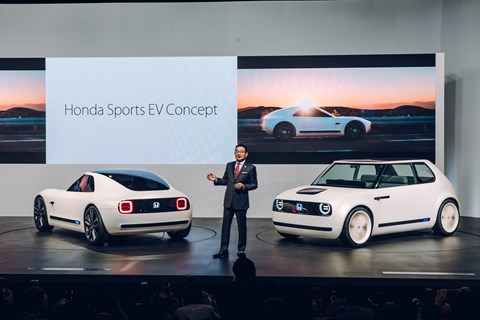
If the Sports EV Concept makes production it’ll sit on the same platform as the Urban EV but details are still hard to come by, almost as if Honda hasn’t yet set these things in stone… Perhaps hard numbers don’t matter; they probably don’t.
Certainly they don’t matter as much as delivering production cars that stay true to the concepts that bought them life. After all, these are the shapes the world’s fallen in love with and nothing – not impact structures, not pedestrian safety requirements and not the restraints of conventional engineering – should be allowed to contaminate them. Over to you, Honda.
Turning the European and global tide
In Tokyo, Honda CEO Takahiro Hachigo repeated his pledge that two-thirds of Honda’s European car sales would be electrified by 2025 – an indicator of the seismic changes afoot when you consider Honda’s track record for sublime petrol engines and the obvious pride it takes in creating them.
That said, Hachigo also repeated his belief that battery-electric vehicles are the stepping stone to the ultimate nirvana of hydrogen fuel cells, and not the final destination. Perhaps, but the challenges between where the world is right now and Hachigo’s dream are, by his own admission, significant and myriad.
A special mention for 100 million Cubs
A few feet from its EV Concepts could be found a special edition Super Cub two-wheeler celebrating a minor production milestone – a trifling 100 million units…
Honda claims 28 million global customers, of which a good chunk are on Cubs, and the Super Cub, together with the gravity-defying Honda Riding Assist-e concept next to it, perfectly encapsulated Honda’s newfound fluency in both the old and the new.
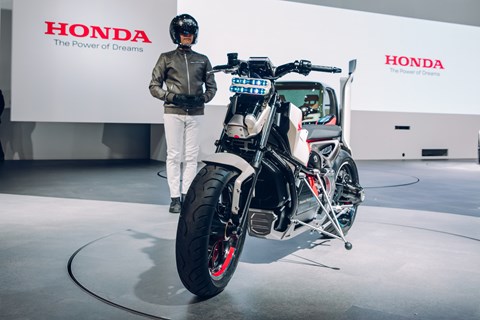
The Super Cub is 20th century excellence; petrol power, primarily mechanical, supremely fit-for-purpose, difficult to balance at a standstill, as all two-wheelers are. The Assist-e concept is 21st century excellence; electric power, primarily digital, supremely fit-for-purpose and impossible to fall off thanks to balance control systems spun from Honda’s Asimo robotics project.
To see an intrinsically unstable two-wheeler sit there, bolt upright, with a servo motor gently twitching its steering to stop it falling over, is to realise there are no absolutes when this much effort is brought to bear. Creating safe, self-driving cars and sexy EVs looks like a walk in the park after perfecting a motorcycle that won’t fall over.
Subaru regaining its mojo in style
Elsewhere, Subaru went through the future-ready motions with its Viziv concept while at the same time barely containing its excitement as it announced a couple of high performance WRX STI variants, the gloriously unrepentant 450-unit S208 and the Type RA for North America.
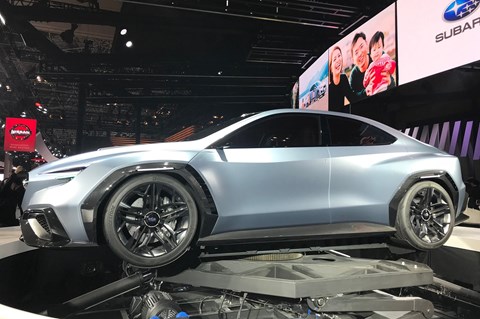
Mitsubishi was more convincingly progressive, the brand having found itself in bed with Nissan and Renault and suddenly in possession of a very bright future. Proof? The e-Evolution concept, a car you won’t be able to buy any time soon but one that nevertheless, like Nissan’s NISMO Leaf and Honda’s Sports EV Concept, gives cause for hope – the end of the engine may not necessarily mean the end of driving fun.
Mitsubishi: ‘An EV can be fun’
As Vincent Cobee, Mitsubishi’s corporate vice president and global planning head puts it, ‘The e-Evolution Concept is an inspiration. It’s not a car we’ll sell in the visible future but it has inside a lot of the genes of our future brand. And it dares to make a statement – that an EV can be fun.’
Looking like Mad Max’s Sunday plaything and boasting a three-motor, four-wheel-drive powertrain that doffs its cap to the legendary Lancers’ fabulously complex, physics-defying engineering, the e-Evolution looks like more fun than robot cabaret – and that’s saying something. Whatever form it finally takes, the car of the future might just be extraordinary to drive – and kampai to that.